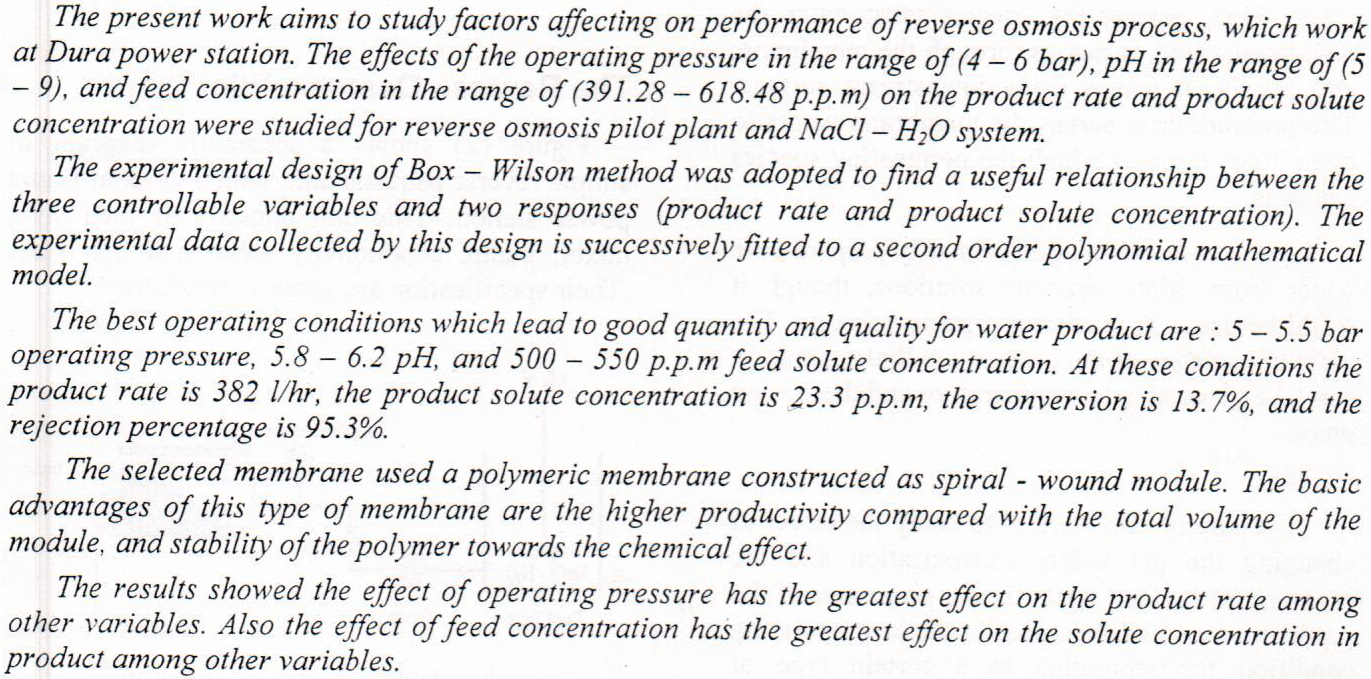
Electro coagulation treatment was used for zinc removal from electroplating wastewater of the State Company for Electrical Industries . This wastewater, here consists zinc ions with maximum concentration in solution of 90 ppm .
The parameters that influenced the wastewater treatment are: current density in the range 1-1.4 mA/cm2, pH in the range 5-10, temperature in the range 25-45°C and time in the range 10-180 minute.
The research is a laboratory experimental type using batch system for electrical process with direct current. The cell comprised of aluminum electrode as anode and stainless steel electrode as cathode. Thirty experiments and one hundred fifty sample lab tests were carried out in this research
... Show MoreThe most popular medium that being used by people on the internet nowadays is video streaming. Nevertheless, streaming a video consumes much of the internet traffics. The massive quantity of internet usage goes for video streaming that disburses nearly 70% of the internet. Some constraints of interactive media might be detached; such as augmented bandwidth usage and lateness. The need for real-time transmission of video streaming while live leads to employing of Fog computing technologies which is an intermediary layer between the cloud and end user. The latter technology has been introduced to alleviate those problems by providing high real-time response and computational resources near to the
... Show More (7)
(7)
 (4)
(4)
Agent technology has a widespread usage in most of computerized systems. In this paper agent technology has been applied to monitor wear test for an aluminium silicon alloy which is used in automotive parts and gears of light loads. In addition to wear test monitoring، porosity effect on
wear resistance has been investigated. To get a controlled amount of porosity, the specimens have
been made by powder metallurgy process with various pressures (100, 200 and 600) MPa. The aim of
this investigation is a proactive step to avoid the failure occurrence by the porosity.
A dry wear tests have been achieved by subjecting three reciprocated loads (1000, 1500 and 2000)g
for three periods (10, 45 and 90)min. The weight difference a
The removal of Ibuprofen antibiotics (IBU) by photo-degradation UV/H2O2/Fe+2 system was investigated in a batch reactor under different initial concentrations of H2O2 (100-500) mg/L, Fe+2 (10-40) mg/L, pH (3-9) and initial concentrations of IBU (10-80) mg/L, and their relationship with the degradation efficiency were studied. The result demonstrated that the maximum elimination of IBU was 85.54% achieved at 300 mg/L of H2O2, 30 mg/L of Fe+2, pH=3, and irradiation time of 150 min, for 10 mg/L of IBU. The results have shown that the oxidation reagent H2O2 plays a very important role in IBU degradation.
 (6)
(6)
 (2)
(2)
 (1)
(1)
Objective: Conventional approaches for disinfection, including spraying and immersion, resulted in only surface disinfection of impressions. As a result, self-disinfecting impression materials incorporated with antimicrobial compounds require more extensive studies. The incorporation of a disinfectant into irreversible hydrocolloid impression materials could eliminate the need for the disinfection step by conventional approaches, including spraying and immersion which only result in surface disinfection of impressions. The study was aimed to investigate the effect of incorporation of hypochlorous acid in irreversible hydrocolloid materials on antimicrobial efficiency, detail reproduction, and dimensional stability. Materials and
... Show MoreThe fresh water green alga Chlorella vulgaris was selected to study its ability to degrade one of polycyclic aromatic hydrocarbon (PAHs)known is anthracene (ANT). ANT is widely used in artificial products such as wood preservatives; insecticides; dye and coating materials. This algae was cultivated in CH-10 medium under constant laboratory conditions and exposed to different concentrations (1, 3, and 5 mg/l) of anthracene for 3, 5, 7, 9 and 15 days, with the concentration of ANT measured by high performance liquid chromatographic analysis (HPLC). The results showed that C.vulgaris has high ability to reduce anthracene to 80% at 1mg/Lcon centration after 3 days and 100% after 5 days, while at 3 and 5 mg / L concent
... Show More (4)
(4)
 (1)
(1)
The chemical composition of wastes of pressed grapes and found that the main components of wastes of pressed grapes, represented by the percentage of moisture was 6.47%, and the proportions are 3.71%. Either carbohydrates amounted to 85.77 %, either in fat models using petroleum ether Petroleum ether) was the increase of 0.27%. estimated the percentage of ash in the sampls was 3.78%, either fiber reached 69.47 %,, in addition to the test extracts towards the growth of seven types of bacteria, which included Bacillus subtilis, Bacillus cereus, Bacillus stearothermophilus, Escherishia coli, Staphylococcus aureus, Salmonella typhimurium and Pseudomonas fluorescens and yeast Candida albicans and Kluyveromyces marxianus, ( diffusion method ).
... Show More